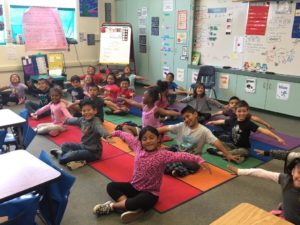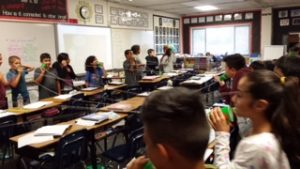 In the second article in the series discussing inclusion, IB World speaks to teachers about how their policies are creating engaging learning experiences for all students
In the second article in the series discussing inclusion, IB World speaks to teachers about how their policies are creating engaging learning experiences for all students
“Inclusive, good-quality education is a foundation for dynamic and equitable societies,” said South African social activist Desmond Tutu. IB World Schools across the globe agree and are leaning on their student-centered inclusion policies to enable supportive learning environments. Recognizing the diverse range of gifts and talents of all students can develop confident learners who are motivated to succeed.
Inclusion can look different in every school, as we discussed in the first article. But one thing that all schools have in common is that their support extends far beyond learning difficulties. It encompasses all students who may struggle with their studies; be it learning differences and disabilities, language development, neurodiversity, mental health disorders, issues around gender and sexuality, as well as difficult family situations.
 Supporting all students
Supporting all students
Dwight School, in New York, US, has extensively used the IB’s candidates with assessment access requirements’ document to design authentic assessment environments for all students.
“For example, if a student receives laptop accommodations for their IB Diploma Programme (DP) exams, we allow students to use the laptop in their courses so they are always experiencing an authentic assessment environment,” says Matthew Gonzales, Director of Curriculum and Instruction and DP Coordinator.
The school began its inclusion journey around 25 years ago when it introduced the Quest Program. It is designed to support a wide range of students – including students with cognitive impairments. “The level and degree of support varies based on the individual needs of each student. As the Quest department grew, the philosophy of inclusion spread through the Dwight School,” says Gonzales.
Quest teachers work closely with classroom teachers and emphasize the importance of affirming identity and building self-esteem as the building block of good teaching practice.
Dwight School has a multifaceted approach to whole-school inclusion. Starting with the admissions process, Josh Kigel, Director of Quest, works with the admissions team to implement plans to support all members of the student body. All students complete a diagnostic exam prior to entry to determine appropriate course placements.
“The exam is tense, but contains questions that are designed to ascertain what students know and understand in a particular subject area. Students complete diagnostic assessments in language and literature, language acquisition and mathematics,” says Gonzales.
 Evolving inclusion policies
Evolving inclusion policies
Chadwick International, in South Korea, has worked to be an inclusive environment since it was founded seven years ago. With changes to the local community – including a more diverse population requiring international schooling – students who would not typically meet rigorous enrollment requirements drove a process of defining Chadwick’s inclusion policy, as well as teaching and learning practices.
“As more diverse students were admitted, our inclusion policy and accompanying practices had to reflect our enrolment policy – that all students can be successful learners,” says Caroline Rennie, Director of Studies.
This coincided with the implementation of the DP and the Middle Years Programme (MYP).. We were able to understand from the beginning how we would use these frameworks to develop our unique experiential learning experience.
The school provides pathways for language fluency and mathematics, as well as different pathways to graduation. It uses responses to intervention (RTI) to gauge student need and psycho-educational testing.
All students with specific learning disabilities have their own best coping mechanisms, and the IB recognizes that the same accommodations will not be appropriate for all students.
“We have a young man with a reading disorder whose mother tongue is Korean. He finds audio recordings very difficult, as it is a new accent to unpack and understand in a stressful, time-sensitive situation. Being able to designate audio, a reader or a quiet place for him to read aloud to himself shows how forward thinking the IB is about inclusion.”
“A student who struggles with processing speed can seem ill-prepared for the rigor and pressure of the full DP,” she adds. “However, knowing that accommodations include time for thinking and speaking in oral assessments, allowing a prompter, reader and scribe for tests, and flexibility specific to his needs, this student is off to a solid start on his journey to the full DP.”
Support teachers work with groups of students to provide one-on-one support, and teachers to collaboratively plan units that support scaffolding, accommodations and modifications, and mother tongue learning.
“Our school administrators are active in acquiring new knowledge for where student neurodiversity overlaps with the disciplinary sphere. Slowly, the culture is changing toward acceptance of difference and the reliability of support.
“Schools often overlook the need an effective librarian for continual development of resources at multiple reading levels, in different styles and many languages,” says Jodi Kittle, Learning Support Specialist at Chadwick International.
Eliminating the stigma
Alvin Dunn IB World Elementary School in California has just finished its first full year of using inclusionary school practices in grades TK-6, and it’s been “amazing”, says Renee Hasan, Elementary Learning Center Teacher. Previously, some grade levels had slowly been implementing inclusionary practices into their daily routines.
The school has a range of student populations ranging from students with mild to moderate and moderate to severe disabilities, preschool reverse mainstreaming, and second-language learners.
Our greatest celebration this year has been putting our students with mild to moderate disabilities onto general education rosters. This has helped foster more inclusive school practices throughout our entire school.
Special education and general education teachers worked collaboratively to create a variety of co-teaching strategies and developed lessons that are universally designed for all students to access. Students received their grade level academic instruction from teachers with support from an education specialist or instructional aide.
“This model of instruction has also been integral in eliminating the stigma of special education versus general education students among students and teachers. Now, many of our students identify as having two teachers while our staff see everyone in their class as ‘our’ students rather than ‘those’ students,” adds Hasan.
“All of our students, regardless of ability, have accelerated academically, behaviorally, and social/emotionally. In the primary grades, we have been able to provide early intervention to such the extent that our numbers of students requiring response to intervention has decreased.
“This in turn has lowered the amount of students that are identified with a disability. Students are also learning skills like self-advocacy and building stronger communication skills among their peers.
“I am so proud to be at a school that celebrates students abilities,” says Hasan.
 Commitment to teacher support
Commitment to teacher support
A whole-school approach is necessary for an effective inclusion policy, but for it to be successful in its delivery teachers must feel supported, too.
On-going professional development and the swapping an sharing of information is important, says Gonzales: “The Quest Department uses the Meeting student learning diversity in the classroom document as a resource to share with classroom teachers who may not have a formal background in SEN (special educational needs).”
“Professional development experiences must be ongoing – there must be a commitment to providing training and support to faculty,” adds Kigel. “Whenever possible, school communities should create time in teachers’ schedules to allow for research, planning and reflection.”
Useful learning resources
The following IB documents have been produced to support schools and can be found on the programme resource centre:
- Learning diversity and inclusion in IB programmes (2016)
- The guide to inclusive education: a resource for whole school development (2015)
- Candidates with assessment access requirements – (Middle Years Programme) (2015)
- Meeting student learning diversity in the classroom (2013)
- Candidates with assessment access requirements (2009)
